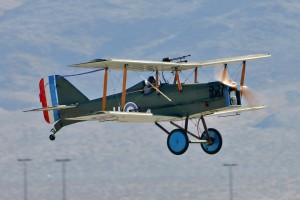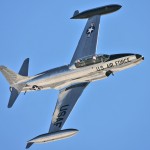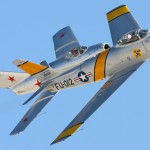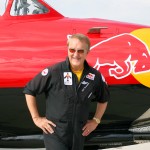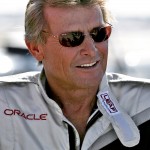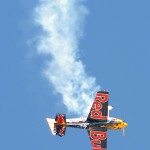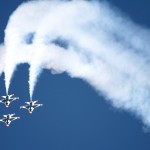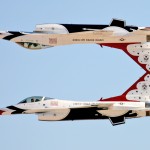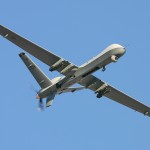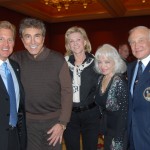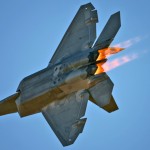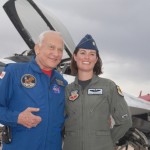By Victor G. Archer
Aviation Nation 2007, held at Nellis Air Force Base near Las Vegas, Nev., was the capstone event for the U.S. Air Force 60th anniversary and the largest Air Force event of the yearlong celebration. Held Nov. 9-11, the theme for the show was “Heritage to Horizons,” commemorating six decades of air power.
World War I aircraft demonstration
Two World War I aircraft performed at this year’s show. A 70-percent scale replica of a 1917 de Havilland DH-4 biplane, built and flown by 82-year-old Roy McCaldin, flew during the event. McCaldin, a decorated veteran from World War II, flew B-17s in the 8th Air Force. The other aircraft in this demonstration was a 7/8th scale SE-5A built and flown by 76-year-old Joe Harr. Both of these aircraft are multi-time award-winning replicas.
Next, a group of five Boeing PT-13/17 Stearman biplanes made several formation flybys, with Denny Don flying his beautifully restored 1942 Ryan PT-22 (ST3KR) and John Anson piloting a North American SNJ-5 Texan. They made several passes profiling their aircraft to the crowd.
World War II fighter and bomber demonstration
The World War II fighter and bomber aircraft demonstration was divided into three sections, including a Doolittle Raiders reenactment by a pair of North American B-25 Mitchells. Heavenly Body and Executive Sweet, came in low and fast, pitched up, and then opened the bomb bay doors for their mock attack on the field.
The next two aircraft are both unique and rare examples of fighter aircraft used during WWII. Featured was a Supermarine Spitfire Mk 1X full-scale replica, built and piloted by Robert DeFord. The Spitfire is powered by an Allison V-1710-63 that produces 1,325 hp and turns a cut-down DC-3 propeller. DeFord chased Jason Somes in the Commemorative Air Force’s Japanese-built Mitsubishi A6M3 Zero.
Liberty Belle, a B-17G Flying Fortress, and Old 927, a B-24A Liberator, represent two of the finest restored planes in their class: the heavy bombers of WWII. Liberty Belle was sold in June 1947 for scrap but was somehow spared. Pratt & Whitney purchased the plane later that year for $2,700 and operated it from1947 to 1967 as a heavily modified test bed for their P&W T-34 and T-64 turboprop engines. Aviation enthusiast Don Brooks, founder of the Liberty Foundation, purchased the aircraft and restoration began in 1992; on Dec.8 2004, Liberty Belle once again returned to the skies.
General Dynamics produced the first B-24A Liberator bombers (LB-30) for the British Royal Air Force. Old 927, the18th LB-30 of an order of 20, was involved in an accident in New Mexico in July 1941. Consolidated rebuilt it to a transport plane (AM-927) and used it as a company aircraft throughout World War II. The CAF acquired the plane in 1967. Painted in the markings of the 98th Bomb Group, the aircraft went by the name of Diamond Lil until May 2007, when it was returned to its original configuration as a B-24A Liberator, with a new paint job, nose art and name.
A short break from the action in the sky, while the Air Force Thunderbirds did engine run-ups and system checks, created an excellent opportunity to see some of the more than 100 military and civilian aircraft on ground display. They included an F-22 Raptor, CV-22 Osprey, Fairchild-Republic A-10 Thunderbolt II, Boeing B-52 Stratofortress, C-17 Globemaster III, McDonnell Douglas KC-10 and KC-135 fueling tankers, F-15s, F-16s and many more.
Korean air war demonstration

Celebrating the new and the old, a group of five Boeing PT-13/17 Stearman biplanes flies past the Air Force Thunderbirds.
The next group of aircraft to fly represented the Korean Air War, with aircraft such as a British-built Hawker Sea Fury, one of the few still flying with its original Bristol Centaurs engine, and a Fairey Firefly Mk. 5, owned and piloted by Ed Kurdziel, who spent more than eight years restoring the aircraft to its original condition. Also flying in this group were some of the early jet aircraft, including a Lockheed T-33 Shooting Star, North American F-86 Sabre and Russian MiG-15. Most of the fighter aircraft made several passes, while the F-86 Sabre and the MiG-15 put on a great tail-chase routine across the sky.
Bill Reesman and his Red Bull Mig-17 put on a great aerobatic act, with smoke generators on the wingtip, and pulling up to eight Gs. Reesman’s performance is one of the top MiG acts in the air show industry. He’s spent more than 1,100 hours flying the MiG—more than any other American pilot.
Canadian Hornet demonstration
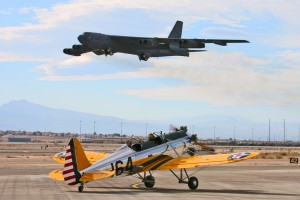
In an amazing contrast of our past and present, a B-52 takes off as Denny Don taxies by in his 1942 Ryan PT-22.
This year, Aviation Nation invited the Canadian CF-18 Hornet National Demonstration Team to perform. Captain Yanick “Crank” Grégoire flew a CF-18 Hornet with a special paint scheme. On brilliant backgrounds of red and blue, the two tails of the Hornet featured stylized graphics celebrating the 25 years of service for the CF-18s in the Canadian forces.
Linebacker II reenactment
Next was a Vietnam-era Linebacker II reenactment. A special announcer acted out the part of the forward air controller who, along with the pilots of the other aircraft, narrated the show as if they were actually performing a combat search and rescue mission in the jungles of Vietnam. Spooky, an AC-47 gunship, provided air cover for the downed pilots. “Sandy,” a flight of two A-1 Skyraiders, gave close air support to the rescue operation. “Dragon,” an OA-37 Dragonfly attack jet, made several bomb runs over the area in support of the operation until a Russian Mig-15 chased it off. “Jolly” (Green Giant), a flight of two UH-1 helicopters, extracted the downed pilots. Finally, an active duty B-52 “BUFF” delivered the bombing run. It was a great reenactment demonstrating the carefully planned interaction between the different aircraft and air support used to recover downed pilots.
Sean Tucker, Kirby Chambliss and more

Two B-25 Mitchell bombers, Heavenly Body and Executive Sweet, took part in the Doolittle Raiders reenactment.
Sean Tucker thrilled the crowd as he performed his signature aerobatic routine over the southern Nevada sky.
Chuck Aaron in the Red Bull helicopter, the Red Bull skydivers and Kirby Chambliss performed next. After the skydivers were safely on the ground, Chuck Aaron executed some extreme aerobatics in his helicopter. He’s the only pilot licensed by the Federal Aviation Administration to perform aerobatics in a helicopter. Kirby Chambliss, flying the Red Bull Edge 540, preformed a terrific aerobatic routine right after Aaron landed. Chambliss, a former captain of the U.S. Aerobatic Team, has won four U.S. national aerobatic championships.
Ed Hamill and Dream Machine, the “Air Force Reserve Biplane,” flew next. In his routine, Hamill dived and rolled through three different acts: barnstorming, aerobatic competition and sky dancing. His demonstration took viewers through a tour of the last 100 years of flight; beginning with a tribute to the first flight at Kitty Hawk, he finishes with a sky dancing demonstration.
U.S. Air Force demonstrations

The Liberty Foundation’s World War II-era B-17G Flying Fortress, Liberty Belle, has been beautifully restored.
The U.S. Air Force Thunderbirds, celebrating their 60th anniversary, took to the skies next. They thrilled guests with precision flying, from their six-aircraft Delta formation to the opposing solos.
An Air Force flyby featured the MQ-1 Predator and the MQ-9 Reaper, medium-to-high altitude, long-endurance, remotely piloted aircraft. The primary missions for the Predator and Reaper are the interdiction and armed reconnaissance against critical targets. The basic crew for the unmanned aircraft is one pilot and two sensor operators. They fly the aircraft from inside a ground control station via a line-of-sight data link or a satellite data link for beyond line-of-sight flight.
Major Brian Willits, the A-10 West Coast Demonstration Team pilot, displayed the A-10 Thunderbolt’s excellent maneuverability at low air speeds and altitude. The A/OA-10 Thunderbolt II is the first Air Force aircraft specially designed for close air support of ground forces. They’re simple, effective and survivable twin-engine jet aircraft capable of use against all ground targets, including tanks and other armored vehicles.

Old 927, one of the very first Consolidated B-24A Liberator bombers ever built, flew during the World War II flight demonstration.
Maj. Paul “Max” Moga was the first pilot selected for the Air Combat Command’s F-22 Raptor Demonstration program. Moga gave the crowd a demonstration of the F-22’s capabilities, exhibiting maneuvers such as the “Mongo Flip,” “J Turn” and “Pedal Turn.” Moga also performed full afterburning muscle climbs and high G turns, all of which highlighted the unprecedented agility of the Raptor.
- This Fairey Firefly Mk. 5, owned and piloted by Ed Kurdziel, is one of a select number of aircraft to win the Rolls Royce Heritage trophy for best restored aircraft.
- John Kezele performs in Kay Eckardt’s highly polished CT-133.
- A North American F-86 Sabre, flown by Steve Hinton, and a Russian MiG-15, flown by Chris Fahey, put on a great dogfight during the Korean air war demonstration.
- Bill Reesman stands next to his Red Bull Mig-17.
- The Red Bull MiG makes a high-speed pass with the afterburner on.
- Capt. Yanick “Crank” Grégoire flies the Canadian forces’ CF-18 Horne.
- Flying in the Vietnam-era reenactment, this Douglas AD-4N Skyraider originally flew in the French air force as no. 56. It also flew in Chad’s air force before returning to the U.S. in 1989.
- An active duty B-52 from 2nd Bomb Wing at Barksdale Air Force Base, Louisiana, was included in the Vietnam-era reenactment.
- Sean D. Tucker, in the Oracle Challenger, makes an inverted pass down the flight line.
- Sean Tucker takes a moment to greet air show fans.
- Chuck Aaron flies upside down while performing a loop in the Red Bull helicopter.
- Kirby Chambliss hangs out next to his Red Bull Edge 540.
- Kirby Chambliss, flying the Red Bull Edge 540, demonstrates his mastery of aerobatics to air show guests while falling like a leaf in an inverted flat spin.
- Ed Hamill performs his sky dancing demonstration in the Air Force Reserve Biplane.
- The U.S. Air Force Thunderbirds four-ship formation rolls high above show center.
- The two Thunderbird solo pilots, Maj. Ed Casey, #5, and Maj. Samantha Weeks, #6, perform the mirror pass.
- The MQ-9 Reaper unmanned reconnaissance aircraft makes its flyby.
- Curtis Wilson (left), director of special projects for Aviation Nation, visits with Steve and Elaine Wynn and Lois and Buzz Aldrin (right) at the Wynn Hotel and Resort, where the Heritage to Horizon’s salute to the USAF 60th anniversary was held.
- A QF-4 Phantom was one of the many service aircraft on display at Aviation Nation.
- Maj. Paul “Max” Moga, in the F-22 Raptor, makes a high-speed turn using full afterburners and vectored thrust.
- L to R: Buzz Aldrin, Tom Henricks and Charlie Duke gravitated together for this photo at the Heritage to Horizons banquet. Aldrin and Duke are former Apollo mission moonwalkers. Henricks, currently president of Aviation Week, is a former shuttle commander
- National Aviation Hall of Fame nominee Sean Tucker (left) ran into fellow nominee and past Air Force Association chairman, Ollie Crawford, and his wife, Nancy, in the hospitality chalet. The renowned air show performer will be inducted in July.
- While meeting the USAF Thunderbirds jet demonstration team and crew, Buzz Aldrin traded fighter pilot stories with Maj. Nicole Malachowski, who in 2006 became the first female demonstration pilot on any U.S. military high performance jet team.
- During a tour of the air show ramp on Nov. 9, NAHF enshrinee Buzz Aldrin visited with the Thunderbirds. Maj. Paul D. “Max” Moga (second from left), wowed spectators across the country in 2007 and put on a spectacular Raptor show.













